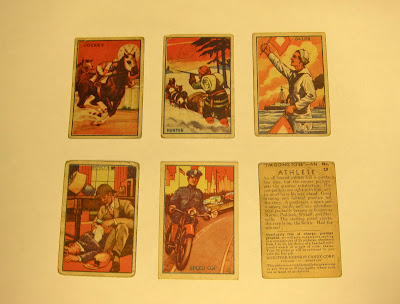Thursday, August 23, 2012
We've Moved!
After more than four years, the "Notes from the Tenement" blog has moved! Please visit us at http://www.tenement.org/blog/ for the latest posts. You can continue to visit this address to view past articles as well.
Monday, August 13, 2012
Shopping for History
The historic shops at 97 Orchard Street were busy places, crammed full of people and goods. To recreate these environments for our "Shop Life" exhibit, we've done a bit of shopping ourselves, collecting historic objects to help us tell stories from dating all the way back to the 1860's.
Kathleen O'Hara, Collections Manager and Registrar, recently revealed some of these objects. Here are some of the highlights:
We know that, in the late 19th century, 97 Orchard Street resident and shopkeeper John Schneider was a member of the Improved Order of Red Men, a fraternal organization that modeled many of its practices after Native American customs. The Red Men were known to dress in feathered headdresses, apply paint to their faces and collect artifacts associated with Native American culture. While Native Americans would have used this type of club as a weapon, for members of the Order of Red Men like John Schneider, this would have been a souvenir and symbol of the fraternity.
What would a German saloon be without a beer barrel? Nineteenth century German saloons were family-friendly gathering places on the Lower East Side. While beer may have been the main attraction for parents of both sexes, whole families gathered in saloons like the one at 97 Orchard Street to enjoy home cooked meals and a lively atmosphere after a long day.

Kathleen O'Hara, Collections Manager and Registrar, recently revealed some of these objects. Here are some of the highlights:
Iroquois war club, Schnieder's Saloon
Beer barrel, Schieder's Saloon
What would a German saloon be without a beer barrel? Nineteenth century German saloons were family-friendly gathering places on the Lower East Side. While beer may have been the main attraction for parents of both sexes, whole families gathered in saloons like the one at 97 Orchard Street to enjoy home cooked meals and a lively atmosphere after a long day.
Sash and bundle of sticks, Schnieder's saloon
These objects are part of the regalia associated with the Oddfellows, another fraternal organization that congregated in the back rooms of saloons on the Lower East Side. The sash is made of velvet with intricate beaded designs. The bundle of sticks is a symbol which can be traced to ancient Roman concepts of strength and unity.
Trading Cards
These trading cards from 1934 were manufactured by the Schutter Johnson Candy-Corp. Collectors of all 25 designs could trade the cards in for various prizes such as a baseball mitt, a wristwatch, or roller skates. Cards depicting a detective, a policeman, a jockey, a hunter, a sailor, and an athlete are included in the Tenement Museum’s collections.
Microphone, Max Marcus' Auction House
A microphone like the one above would have been used by auction-house owners like 97 Orchard Street’s Max Marcus. The microphone, when plugged into a radio, would broadcast the auctioneer’s voice throughout the room. In this image of Marcus' crowded auction house from 1933, we can imagine that it might have been hard to hear Max’s voice even with the microphone!
Undergarments, Sidney's Undergarments
In the 1970s, the Meda family started their own business in the basement of 97 Orchard Street selling ladies undergarments, called Sidney Undergarments Co. These colorful underwear were given to the Museum by the Medas themselves. While these objects will not be on display for Shop Life, they give the curatorial team insight into the styles and prints that were popular at the time.

This is just a fraction of the cool items we have as part of our "Shop Life" collection. We'll keep you posted as we get closer to the exhibit's opening on October 1!
-- Posted by Ana Colon
Thursday, August 2, 2012
Home Remedies from Back in the Day
Summer might bring great weather and shorter work hours, but it can be pretty rough on our bodies. Despite modern medicine and simple solutions found at the local drugstore, sometimes you can’t prevent falling under the weather.
Instead of (or in addition to) Theraflu and Hall's, some people treat their maladies with old school cures passed down from their abuelas and bubbies, or further up the line from their ancestors.
 |
| Image Courtesy New York Public Library |
If you flip through The First Jewish-American Cookbook, published in 1871, you'll find a section dedicated to household cures for pesky seasonal illnesses. Here’s what Mrs. Esther Levy, the author of the book, suggests for our summer woes:
For that cold that sneaked up on you:
“Bathe the feet in warm water; if feverish, take a glass of hot milk with a tablespoonful of the best whiskey and a tablespoonful of lime water, sweetened with sugar; and in the morning, fasting, one tablespoonful of castor oil in milk. Be careful about exposure next day.”
For that cramp you got after getting lost on your way to a subway station:
“Stretch out the heel as far as possible, and at the same time draw the toes as much as possible towards the leg; it will give relief.”
For those mysterious mosquito bites you wake up to every morning:
“Put into a glass or basin of cold water, one ounce of alum, a handful of salt, and two tablespoonfuls of vinegar; run it on at night, and let it dry in the flesh.”
 |
| Image Courtesy New York Public Library |
Feeling inspired by any of these Jewish-American remedies? Were you taught any special cures like these from an elder in your family? Tell us in the comments!
-- Posted by Ana Colon
Subscribe to:
Comments (Atom)







